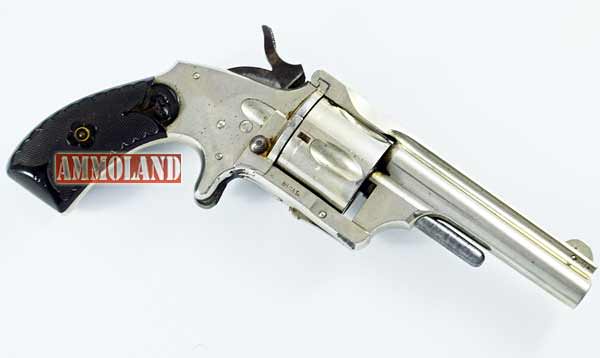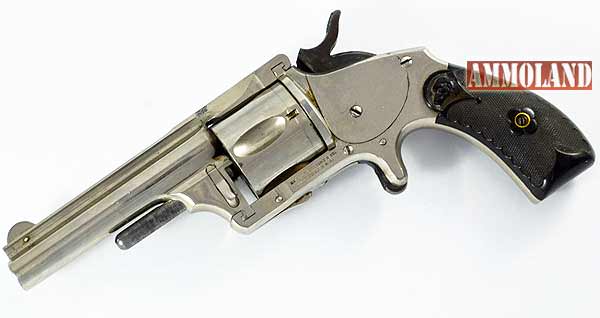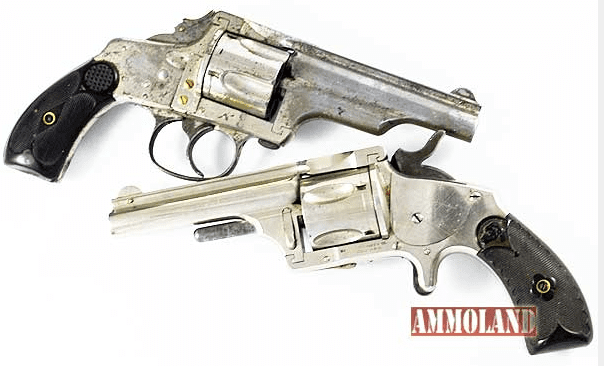Mike Searson writes [via Ammoland.com]
What do Frank Hamer, Jesse James, Pat Garret, Pearl Heart and Bob Dalton have in common? They all carried revolvers made by the same company and the models in question were not built by Smith & Wesson, Colt or even Remington. From the diminutive 32 S&W to the thundering 44 WCF, the model they carried and treasured was considered the most advanced revolver of its time with many features more impressive due to the brief window in history in which they were made. The company was known as Merwin Hulbert and very few of their revolvers have survived the past 125 or so years . . .
History
Joseph Merwin was a firearms distributor of the late 19th century who sold revolvers, rifles and shotguns manufactured by other companies under his name. His first venture of this sort was based in what was then the firearms wholesale center of the world: New York City. His first effort was known as Merwin & Bray Co. In 1873 after Bray left the business, Merwin took up with William and Milan Hulbert, who owned a 50% stake in the Connecticut based firm of Hopkins & Allen.

Hopkins & Allen was not known for producing the best revolvers in the world, but their nickel plating process was said to be second to none and Merwin knew he could offer superior nickel plated revolvers for the price that other companies were offering in blue. These innovative revolvers were branded as “Merwin, Hulbert and Company, New York“, even though they were built in the Hopkins & Allen plant in Connecticut.
The new company soon acquired Phoenix rifles, Evans Rifles and American Cartridge Company (ACC); they were on their way toward becoming a 19th Century Freedom Group. ACC was responsible for producing ammunition with Merwin Hulbert’s own head stamp of “MH”. These rounds were actually 32 S&W, 38 S&W, 44 WCF and a straight walled 44 that was dimensionally similar to 44 Russian.
However due to a different bullet weight and powder charge, the round was considered unique.
Merwin Hulbert was unfortunately beset with a score of financial problems ranging from a loss of payment for three large arms shipments to Russia to the bankruptcy of the Evan’s Rifle Company and an associate of the Phoenix subsidiary stealing the majority of the company account, leaving them literally bankrupt by 1881.
The company stabilized but never fully recovered. After Merwin’s death in 1888 the name was changed to “Hulbert Brothers & Company” and in 1896 the brothers sold their stakes to Hopkins & Allen. Merwin Hulbert revolvers were produced by Hopkins & Allen until 1916 when they in turn, went bankrupt and their machinery was bought by Marlin Firearms.

The Difference
What made Merwins so different from their contemporaries was that the revolvers open up via a twisting action to the side, instead of a break top or being a solid frame.
The cylinder is held in place by vacuum pressure and uses no springs. Likewise, the tolerances are so tight that on a loaded revolver only the empty cases will fall free, leaving the unfired rounds in the cylinder.
A secondary benefit to this design is that the shooter can change barrel lengths without head spacing, timing or cylinder gap issues and the rear of the cylinder is completely covered by a cupped rim on the frame to prevent dirt and debris from entering.

Another innovation found on Merwin Hulbert double action revolvers includes the incorporation of a folding hammer for pocket carry. This gives the shooter the option of cocking it for a better trigger pull when necessary.
The Models
The bulk of Merwin Hulbert’s revolvers were large frame center fire double action and single action six guns intended for use on the frontier or as a military pistol. In working condition with no finish left, these revolvers sell for thousands of dollars with pristine or engraved versions going for much more.
The author’s personal Merwin revolvers come from the medium frame lines. These were the pocket pistols of their day and while still expensive, can be had for a more reasonable price.
The single action version sports a 3 ½” barrel and its chambering of 38 MH meant it was intended as more of a pocket or hideout gun. The hammers do not fold on these miniature single action revolvers and they could be had with either a square or round butt.


This particular example was acquired from a sporting goods retailer who dismissed it as a Hopkins & Allen “suicide special” as that is how the revolver is marked. The price was less than $100 and its value is easily five times that.
Our second Merwin is the double action version and it was marked “Merwin Hulbert & Company”, but as the name was not familiar to that seller, he priced it as if he would any other nickel plated revolver from that time period, $150.
These medium frame revolvers and the small frame double actions chambered in 32 S&W (which held 7 shots) are more commonly found than their big bore counterparts and can be had for somewhat reasonable prices, but only a few thousand of each type was ever made so the supply is rapidly drying up and thanks to the internet, most sellers are savvy to what they have.
There has been an attempt to manufacture these revolvers using modern machinery and materials; however that venture unfortunately turned out to be mostly smoke and mirrors with a number of would-be owners losing deposits they placed for orders that will never be filled.
Some collectors disparage the smaller pocket sized wheel guns from the 1800s in favor of the full size “holster” models, but these little ones are precisely what Hamer and Garrett carried as lawman in the way of back up revolvers. Texas Ranger Frank Hamer famously used his 32 Merwin in a gun fight where he emerged as victor, proving that the diminutive 32 will get the job done with mere black powder loads if the shots are placed correctly.
In 2009 an attempt was made to revive the brand, but like the Merwins of old, the dream was deferred and a parent company (Broadsword Group) was left to the task of refunding deposits for revolvers that were never produced. A number of companies have been in the planning stages to make their own versions, but until that becomes reality, all we are left with are these handsome relics of the late 19th century.
About Mike Searson
Mike Searson’s career as a shooter began as a Marine Rifleman at age 17. He has worked in the firearms industry his entire adult life as a Gunsmith, Ballistician, Consultant, Salesman, Author and was first certified to teach firearms safety in 1989.
Mike has written over 2000 articles for a number of magazines, websites and newsletters including Blade, RECOIL, OFF-GRID, Tactical Officer, SWAT, Tactical World, Gun Digest, Examiner.com and the US Concealed Carry Association as well as AmmoLand Shooting Sports News. Home page: www.mikesearson.com FB: www.facebook.com/mike.





Love some firearms history. Great stuff!
Only fired rounds fall out, but unfired ones stay in? How is that? The brass should expand. Unless if the low pressures of the day meant no expansion.
Interesting design.
That’s what I was wondering too. You might be right about the lower-pressure not causing expansion. I’d love to hear more about it though.
Frequently soft lead ammunition was a thousandth or so greater in diameter than the brass, tapered on the bottom and pressed in with no crimp.
A very close fit would have slight interference between bullet and cylinder.
I have 3 of the smaller ones – .32s and .38 S&Ws. They machining and design is amazing.
When you load the ammo through the side loading gate, the rims fit under a lip in the recoil shield. When you pull the barrel & cylinder forward, all the cases are pulled back out of the cylinder, but the bullets in the still-loaded rounds are too long to clear the back face of the cylinder. The empties are short enough to spill out of the cylinder and “escape” the lip in the recoil shield, but the loaded rounds stay in place while you close the action.
The machining in these revolvers is amazing – in one that is relatively unused, pulling the gun apart creates a vacuum around the cylinder axis pin – it wants to suck the cylinder back unless you hold it firmly. Merwin, Hulberts would probably cost upwards of $2000 to machine today.
Twist breach-ish style action looks pretty cool. Thanks for the write-up.
I have one of the DA 32s and it is an amazing bit of machinery and design. Really were ahead of their time like the Roper repeating shotgun.
A bullet sticking out of the mouth of the case makes the cartridge longer than the fired cases. The empty cases fall free but the unfired ones remain in place. Very clever design.
Love vintage gun porn. As some hold fast to the notion that “Wheel Guns Is Real Guns.”
“An elegant weapon from a bygone age.”
Obi Won Kenobi
Good to know as I get very old revolvers that look like Saturday night specials once in a while. Hate to make an expensive mistake as I have a guy who buys whatever I get…
One of the things I really enjoy is browsing pawn shops I’ve never been to before and finding something that the shop owner has no clue as to how valuable it is…
🙂
The other gun in the photo of Pat Garrett’s revolvers (the blued one, on the left) is a Hopkins & Allen XL Double Action. Two differently branded guns, made by the same manufacturer. The H&A is chambered in “.32 Centre (sic) Fire” (so marked on the top-strap). I have the identical model, although mine is nickel plated, and I believe the “.32 Centre Fire” cartridge the gun was chambered for is the .32 Merwin & Hulbert round. The cylinder is rather long for the .32 S&W cartridge, but the .32 S&W Long cartridge comes right to the end of the cylinder, and some manufacturers’ rounds even protrude slightly. The .32 M&H round is sort of mid-way in length between the short and long S&W .32’s, so would be a proper fit in this gun.
I have an old Plants army revolver that’s stamped Merwin and Bray. Took me a long time to figure out exactly what it was
It belonged to an elderly woman who got it from her father. He was an army chaplain in the Philippines at the turn of the century. The gun was an antique even back then. It’s ugly but the action is crazy smooth
The Plant was an evasion of the Rollin White patent held by Smith & Wesson for bored-through cylinders loaded from the rear – the Plant used a special “cup primed” cartridge that loaded from the front of the cylinder. Some were converted by gunsmiths to handle conventional rimfire ammo.
That’s exactly right. I read they came with two cylinders. A front loader and a regular black powder.
Mine just has the BP left. Anything loose on a gun that old… Who knows where it went
“The cylinder is held in place by vacuum pressure”
Vacuum Pressure, how do that work?
For an example of how this works, get two gage blocks. Make sure that the two surfaces you wish to join are very clean, with no oil, fingerprints or grit.
Wring them together.
There’s an example of precision surfaces staying together once you push all the air between the surfaces out.
More old gun trivia – Marlin made a few top-break revolvers back in the late 1800s – I have one of their double-actions. Kind of a neat old gun, from a maker that everyone associates with rifles.
I have a large frame Merwin Hulbert 1st. model open top with scooped cylinder. The hammer will not “half cock” and the cylinder latch will not retracted to open the action. I somehow got it open by pulling the hammer to full cock, and got the latch open when the hammer released and took a chunk out of my index finger in the process. I cannot close the cylinder now and can’t retract the latch. Can you fix this problem for me? I would like to shoot the gun with black powder loads if it is safe to do so. If not safe, I’ll make it a “wall hanger”, but I would like to get it working as intended. Thanks for your help.
Comments are closed.